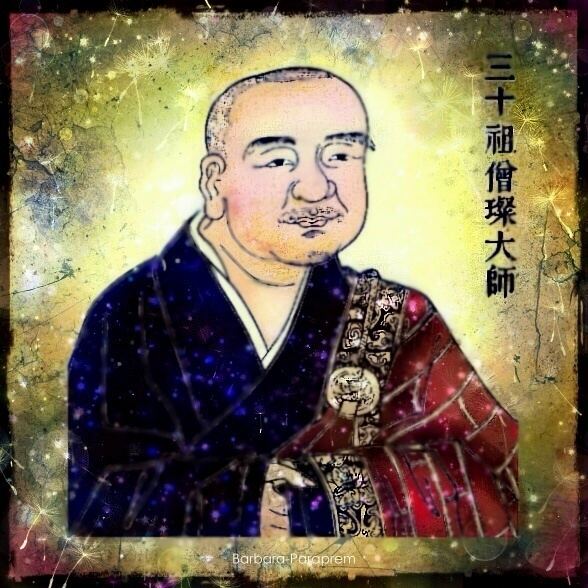School Ch'an Died 606 AD Name Sengcan Sengcan | Role Author Nationality Chinese | |
 | ||
Books The Book of Nothing: A Song of Enlightenment | ||
Jianzhi Sengcan (Chinese: 鑑智僧璨; Hànyǔ Pīnyīn: Jiànzhì Sēngcàn; Wade–Giles: Chien-chih Seng-ts'an; Japanese: Kanchi Sōsan, died 606) is known as the Third Chinese Patriarch of Chán after Bodhidharma and thirtieth Patriarch after Siddhārtha Gautama Buddha.
Contents
He is considered to be the Dharma successor of the second Chinese Patriarch, Dazu Huike (大祖慧可; Hànyǔ Pīnyīn: Dàzǔ Huìkě; Wade–Giles: Ta-tsu Hui-k’o; Japanese: Taiso Eka). Sengcan is best known as the putative author of the famous Chán poem, Xinxin Ming 信心銘 (Hànyǔ Pīnyīn: Xìnxīn Míng; Wade–Giles: Hsin-hsin Ming; Inscription on Faith in Mind).
Biography
The year and place of Sengcan’s birth is unknown, as is his family name.
Huike
It is said that Sengcan (old spelling: Tsang Tsan) was over forty years old when he first met Huike in 536 and that he stayed with his teacher for six years. (Dumoulin, p 97) It was Huike who gave him the name Sengcan (“Gem Monk”).
The Transmission of the Lamp entry on Sengcan begins with a koan-like encounter with Huike:
Sengcan: I am riddled with sickness. Please absolve me of my sin.Huike: Bring your sin here and I will absolve you.Sengcan (after a long pause): When I look for my sin, I cannot find it.Huike: I have absolved you. You should live by the Buddha, the Dharma, and the Sangha.There are discrepancies about how long Sengcan stayed with Huike. The Transmission of the Lamp records that he “attended Huike for two years” after which Huike passed on the robe of Bodhidharma and Bodhidharma’s Dharma (generally considered to be the Lankavatara Sutra), making him the Third Patriarch of Chan.
According to Dumoulin, in 574 the accounts say that he fled with Huike to the mountains due to the Buddhist persecution underway at that time. However, the Lamp records claim that after giving Sengcan Dharma transmission, Huike warned Sengcan to live in the mountains and “Wait for the time when you can transmit the Dharma to someone else.” as a prediction made to Bodhidharma (Huike’s teacher) by Prajnadhara, the twenty-seventh Chan ancestor in India, foretold of a coming calamity.
After receiving transmission, Sengcan lived in hiding on Wangong Mountain in Yixian and then on Sikong Mountain in southwestern Anhui. Thereafter, for ten years he wandered with no fixed abode.
Daoxin
He met Daoxin, (580-651) a novice monk of just fourteen, in 592. Daoxin attended Sengcan for nine years and received Dharma transmission when he was still in his early twenties.
Subsequently, Sengcan spent two years at Mount Luofu (Lo-fu shan, northeast of Kung-tung (Canton)) before returning to Wangong Mountain. He died sitting under a tree before a Dharma assembly in 606.
Dumoulin notes that a Chinese official, Li Ch’ang found Sengcan’s grave in Shu-chou in 745 or 746.
Sengcan received the honorary title Jianzhi 鑑智 (“Mirror Wisdom”) from the Tang dynasty emperor Xuan Zong.
Teachings
Sengcan, like Bodhidharma and Huike before him, was reputed to be a devotee and specialist in the study of the Lankavatara Sutra, which taught the elimination of all duality and the “forgetting of words and thoughts”, stressing the contemplation of wisdom.
However, McRae describes the link between Bodhidharma (and therefore Sengcan) and the Lankavatara Sutra as “superficial”. The link between this sutra and the “Bodhidharma school” is provided in Tao-hsuan’s Further Biographies of Eminent Monks where, in the biography of Fa-ch’ung he “stresses that Hui-k’o was the first to grasp the essence of the Lankavatara Sutra” and includes Sengcan as one who “discoursed on but did not write about the profound message of the Lankavatara Sutra. Due to the lack of authentic evidence, comments on Sengcan's teachings are speculative.
Writings
Although Sengcan has traditionally been honored as the author of the Xinxin Ming (W-G:Hsin-hsin Ming), most modern scholars dismiss this as improbable.
